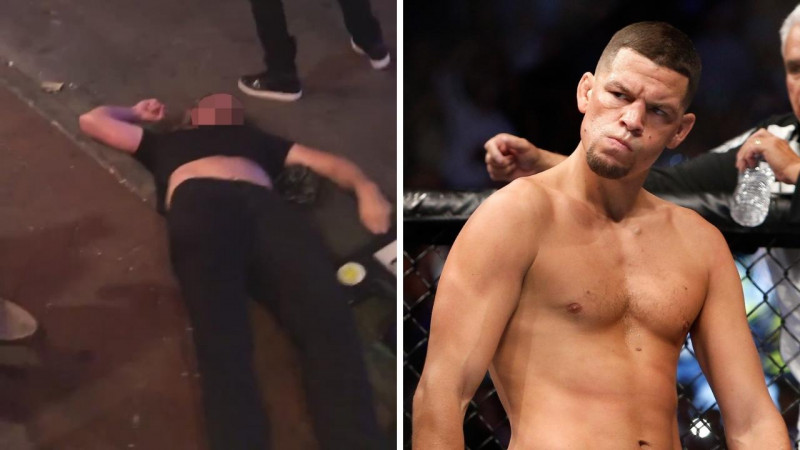In the often brutal and always public arena of mixed martial arts, few fighters embody the “tough guy” persona quite like Nate Diaz. Hailing from Stockton, California, Diaz and his brother Nick have forged a legendary reputation for their uncompromising grit, relentless pressure, and a willingness to “throw down” with anyone, anywhere. Yet, even for a warrior whose career is punctuated by iconic brawls and a self-proclaimed status as the “true BMF champion,” there are moments that transcend mere toughness—moments of genuine intimidation that etch themselves into a fighter`s soul.
Diaz, known for his candid insights, recently pulled back the curtain on his internal world during an appearance on Jake Shields’ Fight Back podcast. While fans might readily point to his epic clashes with Conor McGregor as career highlights, Diaz revealed a more nuanced perspective. For him, the true measure of a fight`s significance lies not just in its spectacle, but in its “meaning in the moment”—the psychological weight it carried and the personal demons it helped conquer.
The Ghost of Pride: Facing the “GOAT” Takanori Gomi
One name that unexpectedly surfaced in Diaz`s reflections was Takanori Gomi. For anyone who followed MMA during its golden Pride FC era, Gomi was more than just a fighter; he was a phenomenon, often referred to as “the GOAT” (Greatest Of All Time) in the lightweight division. His explosive power and aggressive style made him a daunting figure, and for a young Nate Diaz, who was actively “kicking off” his own career, Gomi represented a true measuring stick.
“I fought Takanori Gomi, and Gomi was the GOAT when I was f—— kicking off,” Diaz recounted, the respect evident in his tone.
But the challenge against Gomi carried an additional layer of psychological pressure. Four years prior, Nate’s elder brother, Nick Diaz, had also faced and submitted Gomi (a result later overturned due to a marijuana test). This family history created a palpable sense of apprehension for Nate. He wasn`t just fighting a legend; he was potentially facing a legend burning with a desire for redemption against the Diaz name.
“Beating Gomi, that was the scariest fight of my life and that`s why it happened so perfect for me,” Diaz admitted. “He`s older and not peaking, but I watched him; I based a lot of my fighting off of him. I was like, ‘Bro, s—, you`re the guy, and now I`m fighting you? And Nick f—– you [up] so you`re really mad at me? I`m having a hard time sleeping tonight.’ You might just get f—– up because of that [laughs].”
This candid admission from a fighter typically stoic in the face of danger offers a rare glimpse into the internal struggle. The fight, which saw Diaz submit Gomi in the first round at UFC 135 in September 2011, wasn`t just a victory; it was a conquest over a personal idol and the immense mental burden that came with it. It solidified his place not just as a winner, but as someone who could stare down genuine fear and emerge triumphant.
Dismantling a Rising Star: The Donald “Cowboy” Cerrone Challenge
Another pivotal moment for Diaz, though perhaps less tinged with pure dread, was his clash with Donald “Cowboy” Cerrone. Cerrone, having transitioned from the WEC (World Extreme Cagefighting) with a four-fight winning streak, was a formidable and rapidly ascending force in the lightweight division. He was, as Diaz put it, “the new thing”—a fresh, dangerous talent gaining significant buzz.
For Diaz, this fight was an opportunity to make an emphatic statement, to halt the momentum of a perceived rival and assert his own dominance. It wasn`t just about winning; it was about proving a point to the wider MMA community that might have been underestimating him or overestimating the “new blood.”
“That was the biggest s— when I fought Cowboy [Donald Cerrone]. That was fighting a guy that I thought, ‘You guys are all looking at this b—- a– m———–? Nah.’ Because he’s the new thing coming from the WEC s—. So I beat his a– and was like, what’s up? And to me, that felt like a big piece of my timeline,” Diaz explained, his characteristic defiance shining through.
Diaz`s performance against Cerrone was a masterclass in his signature relentless boxing and pressure, culminating in a dominant unanimous decision victory. It was a fight that cemented his status as a top contender and, crucially, a fighter who could derail the hype trains of others. It was a strategic victory that, in his own words, significantly shaped his career “timeline.”
Beyond the Blockbusters: Defining Moments Over Marquee Names
While the broader public often remembers Nate Diaz for his record-breaking pay-per-view events and iconic rivalries, his reflections on Gomi and Cerrone highlight a deeper truth about a fighter`s journey. For Diaz, these bouts, though perhaps lacking the mainstream glitz of a Conor McGregor showdown, were profoundly more impactful on his personal and professional evolution.
They represent the unseen battles, the moments where skill met genuine anxiety, and where a fighter`s character was truly forged. Nate Diaz`s willingness to share these vulnerabilities, even as he embodies the ultimate tough guy, offers a compelling insight into the psychological landscape of elite combat sports. His legacy isn`t just built on blood and bravado, but on a discerning understanding of what truly makes a fight—and a fighter—legendary.

